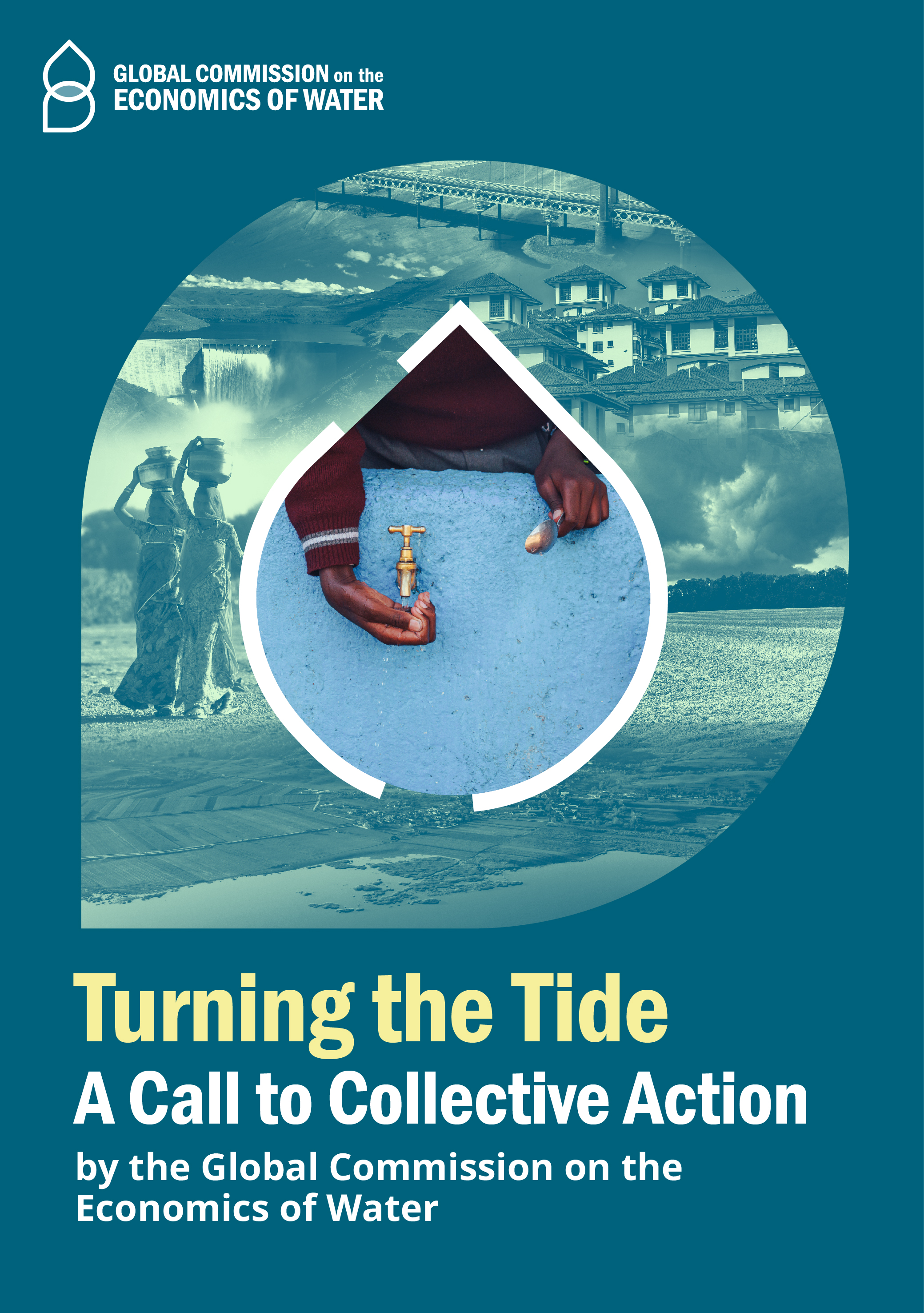By the Global Commission on the Economics of Water
We will fail on climate change if we do not solve water. We will also fail on all the Sustainable Development Goals (SDGs).
No person, place, economy or ecosystem will be spared.
We are seeing the consequences not of freak events, nor of population growth and economic development, but of having mismanaged water globally for decades. As the science and evidence show, we now face a systemic crisis that is both local and global.
Our collective actions have pushed the global water cycle out of balance for the first time in human history, wreaking increasing damage on communities everywhere. Further, countries are interconnected not only through transboundary rivers or streams of groundwater, but also through atmospheric flows of water vapour. And dangerously, we face water’s deepening connection with climate change and the loss of biodiversity, with each reinforcing the other.
We can only fix this collectively. And if we move with urgency.
A seven-point call to collective action
A sustainable and just water future can be achieved. It requires transforming the economics and restructuring the governance of water. We must take actions that are bolder, more integrated, across sectors and more networked at national, regional and global levels.
First, we must manage the global water cycle as a global common good, to be protected collectively and in the interests of all.
It means recognising that communities and nations are connected regionally and globally; that water is increasingly intertwined with climate change and the depletion of the planet’s natural capital; that water is critical to food security as well as all the SDGs; and that water cannot be put back on a sustainable trajectory without justice and equity in every corner of the globe.
Second, we must adopt an outcomes-focused, mission-driven approach to water encompassing all the key roles it plays in human well-being.
We must deliver on the human right to safe water. We must act collectively to stabilise the global water cycle. It means mobilising multiple stakeholders, public, private, civil society and local community; utilising innovation policy to catalyse solutions to concrete problems; and scaling up investments in water through new modalities of public-private partnerships. And we must ensure that the value that is created collectively gets shared widely.
Third, we must cease underpricing water.
Proper pricing along with targeted support for the poor will enable water to be used more efficiently in every sector, more equitably in every population and more sustainably both locally and globally. We must also account for water’s non-economic value in decision-making to ensure we protect nature, on which the planet and all life depend.
Fourth, we must phase out some USD 700 billion of subsidies in agriculture and water each year, which tend to generate excessive water consumption and other environmentally damaging practices.
We must drastically reduce leakages in water systems (“non-revenue water”) that cost billions annually, by prioritising sustained maintenance efforts. We must accelerate efforts to require disclosure of water footprints, which are key to steering capital and consumer preferences in favour of sustainable practices. Each of these steps will allow us to re-direct resources towards incentivising water conservation and universal access.
Fifth, we should establish Just Water Partnerships (JWPs) to enable investments in water access, resilience and sustainability in low- and middle-income countries, using approaches that contribute to both national development goals and the global common good.
JWPs should drive down the cost of capital by using the complementary strengths of every stream of finance—rechannelling today’s inefficient domestic subsidies, leveraging on the multilateral development banks and development finance institutions, and crowding in private companies, banks and institutional investors, and philanthropic money. The economic returns on these investments will vastly exceed their costs. The JWPs should also maximise synergies with climate change strategies and national programs to achieve inclusive growth.
Sixth, we must move ahead on the opportunities that can move the needle significantly in the current decade.
Fortifying freshwater storage systems, especially the natural assets such as wetlands and groundwater, which have been dangerously depleted. Developing the urban circular water economy especially by recycling industrial and urban wastewater, which remains largely untreated. Reducing water footprints in manufacturing, including the reuse of water in producing critical materials such as the lithium we need for electrification. Shifting agriculture to precision irrigation, less water-intensive crops and drought-resilient farming that can also raise incomes. We must drive down the costs of technologies in each case by adopting them at scale.
Seventh, underpinning all our efforts, we must reshape multilateral governance of water, which is currently fragmented and not fit for purpose.
Trade policy must be used as a tool for more sustainable use of water, by incorporating water conservation standards in trade agreements, highlighting wasteful water subsidies and ensuring that trade policies do not exacerbate water scarcity in water-stressed regions. Multilateralism should also support capacity building for all, prioritise gender equality in water decision-making, and empower farmers, women, youth, Indigenous Peoples and local communities, and consumers who are at the frontlines of water conservation.
We are heading for massive collective failure
The disasters of 2022 are a warning of things to come. The unprecedented floods and droughts, cyclonic storms and heat waves, in one region today and another tomorrow. The devastating toll in human suffering, and in some cases, decades of human development wiped out in weeks.
But it is not just these extreme events that tell us we have a crisis on our hands. There is a long-standing tragedy that does not make the headlines. More than two billion people still lack access to safely managed water. One child under five dies every 80 seconds from diseases caused by polluted water. Hundreds of millions of children grow up stunted, their potential in life sharply diminished.
The crisis has already pushed whole communities and regions in the Global South into severe food insecurity. The water-energy-food nexus, made worse by food export restrictions, has also contributed to major food price spikes in the last 15 years, exacerbating their suffering.
Without urgent action, the damage will accelerate and grow more severe in all these critical dimensions.
We are seeing the consequences not of freak events, nor of population growth and economic development, but of our mismanagement of water globally for decades. We have changed rainfall patterns and failed to preserve freshwater ecosystems, to manage demand to avoid overuse, to prevent contamination, to foster recycling and to develop and share water-saving technologies. We now face the prospect of a 40% shortfall in freshwater supply by 2030, with severe shortages in water-constrained regions.
And fundamentally, as the science and evidence show, this mismanagement of water has pushed the global water cycle out of balance for the first time in human history. We have breached the planetary boundaries for water that keep the Earth’s system safe for humanity and all life.
Dangerously, the water crisis is increasingly intertwined with global warming and the loss of biodiversity, with each reinforcing the other. The cumulative impacts on the climate and biosphere are changing the source of all freshwater—precipitation—and that is resulting in a shift in the supply of water across the entire world. A key driver is global warming—a global energy imbalance that intensifies the water cycle, adding about 7% of moisture for each 1°C of global mean temperature rise. In addition, land use change (predominantly deforestation, wetland depletion, land degradation and infrastructure development) is now impacting precipitation patterns, and how rain is partitioned between green (soil moisture/vapour) and blue water (runoff/liquid) flows.
However, water is not just a casualty but also a driver of the climate crisis. Behind all carbon storage in nature, there is freshwater. Extreme water events cause an immediate loss of carbon uptake in nature. Droughts lead to fires and massive loss of biomass, carbon and biodiversity. The loss of wetlands is depleting the planet’s greatest carbon store, while the drop in soil moisture is reducing the terrestrial and forest ecosystem’s ability to sequester carbon. It risks turning these natural ecosystems into sources of greenhouse gas emissions in the years to come, with devastating consequences for the pace of global warming.
We will fail on climate change if we fail on water. Equally, we have to coordinate our strategies for the two to ensure that the transition to low emission energy sources reduces, rather than increases, pressure on scarce water resources. We should also recognise water’s critical role in climate mitigation and adaptation strategies, including the role of wetlands in providing resilience against floods and droughts. If we don’t plan this properly, there is real risk that we both exacerbate the water crisis and undermine efforts to halt and reduce the costs of climate change itself.
We must also recognise that communities and countries are interconnected through the global water cycle. They are not only interconnected by transboundary blue water flows but also through green water, i.e., atmospheric green water flows of water vapour, flows which expand extend far beyond traditional watershed boundaries.
- Precipitation—the source of all freshwater—is for each country in the world determined by a number of factors: domestic water use and governance, collective management of the climate system, as well as the state of neighbouring countries forests and other ecosystems as they generate green water flow, which turns into rainfall when moisture is recycled and travels downwind.
- Moisture recycling studies have shown that continental green water flow is important for many regions to sustain their precipitation. Globally, about 40 to 50% of terrestrial precipitation originates from vapour flow over land via green water moisture recycling. Countries are interconnected via atmospheric moisture pathways directing evaporation through the atmosphere to precipitation in downwind areas, creating so-called precipitation sheds (source areas) and evaporation sheds (sink areas) of rainfall. Figure 1 illustrates the extent and volumes of green water flows across the world including terrestrial moisture imports, exports and internal recycling across regions.
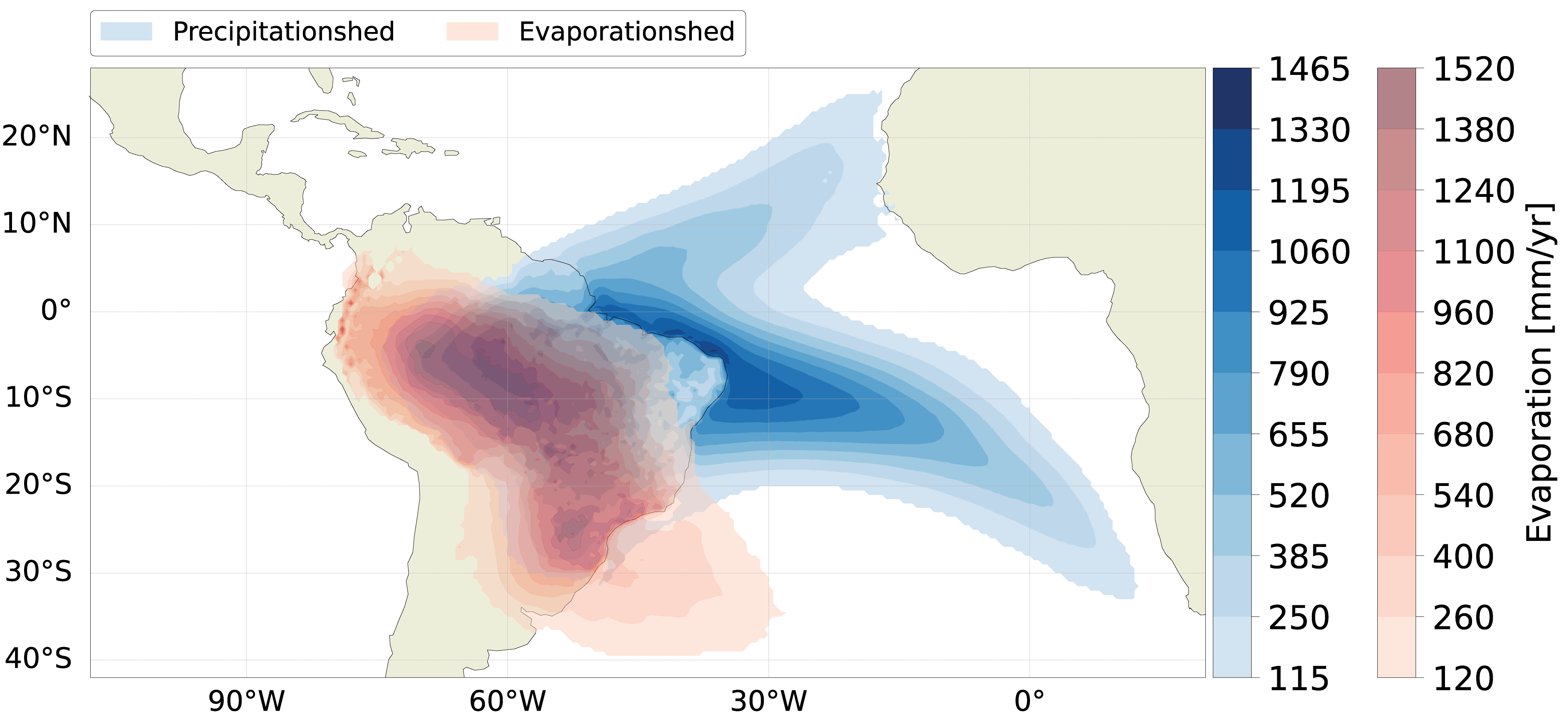
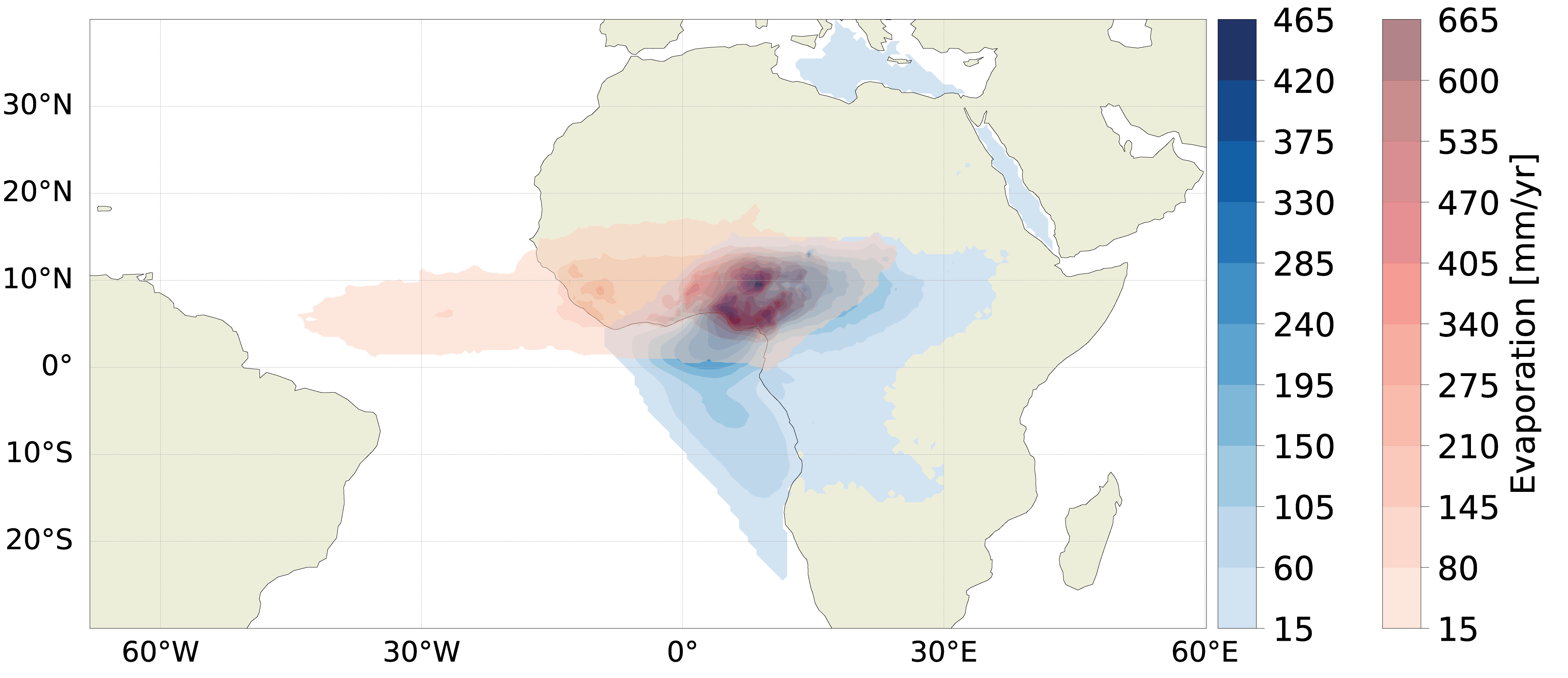
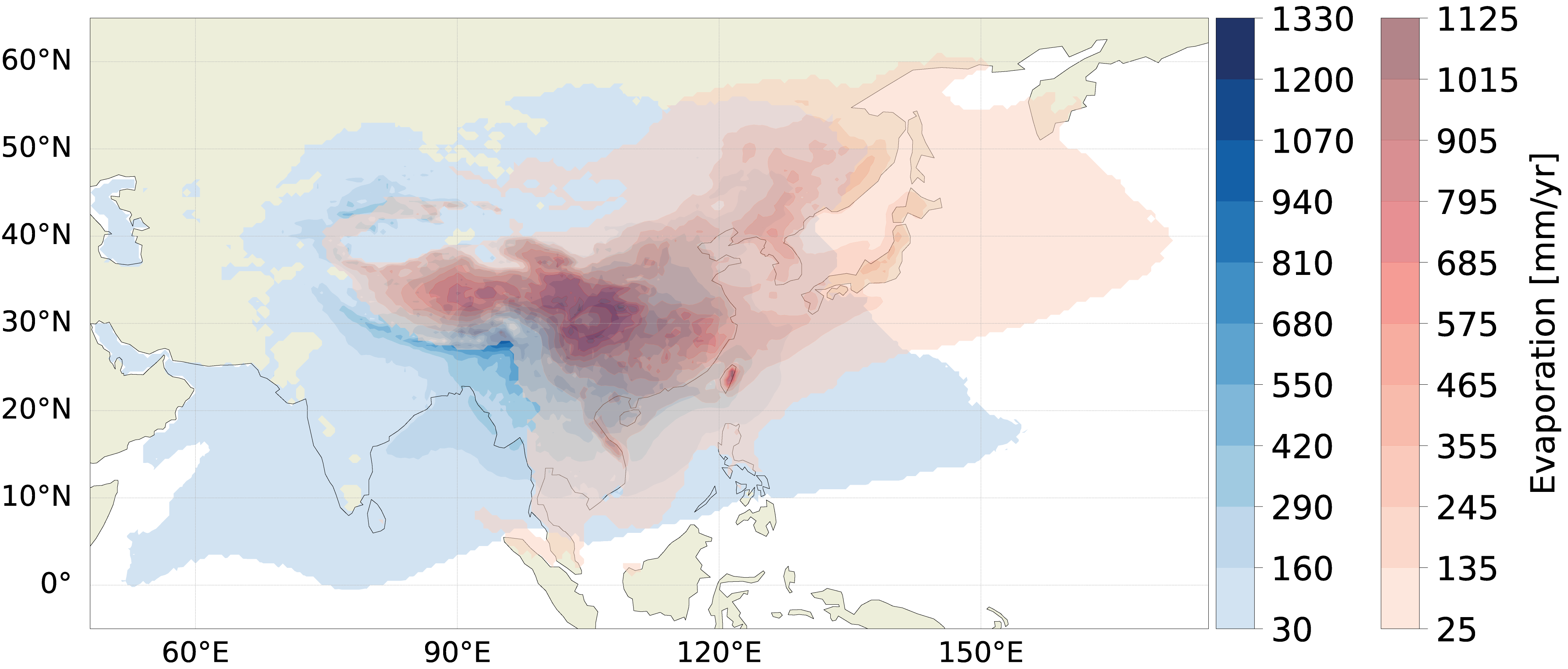
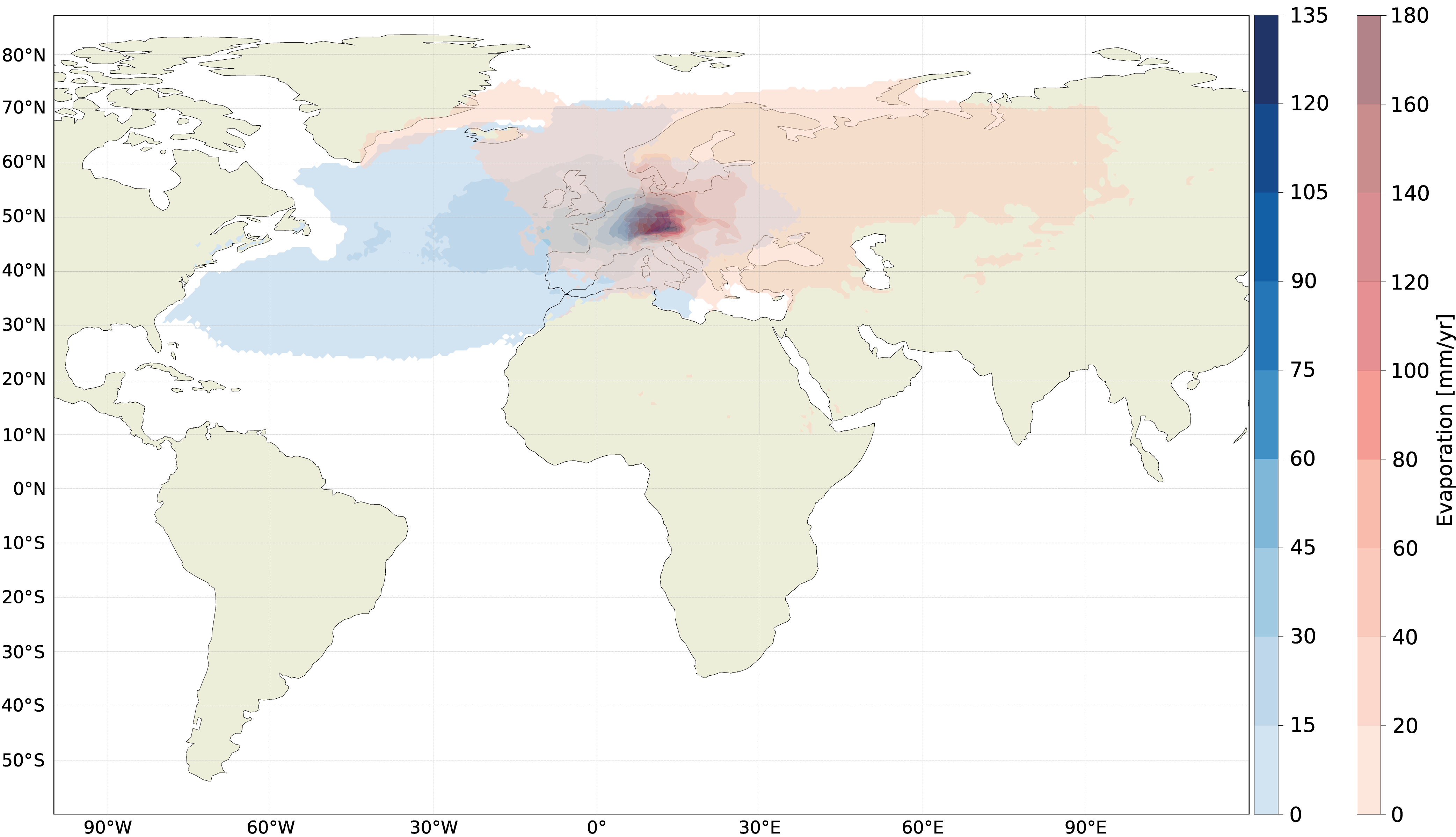
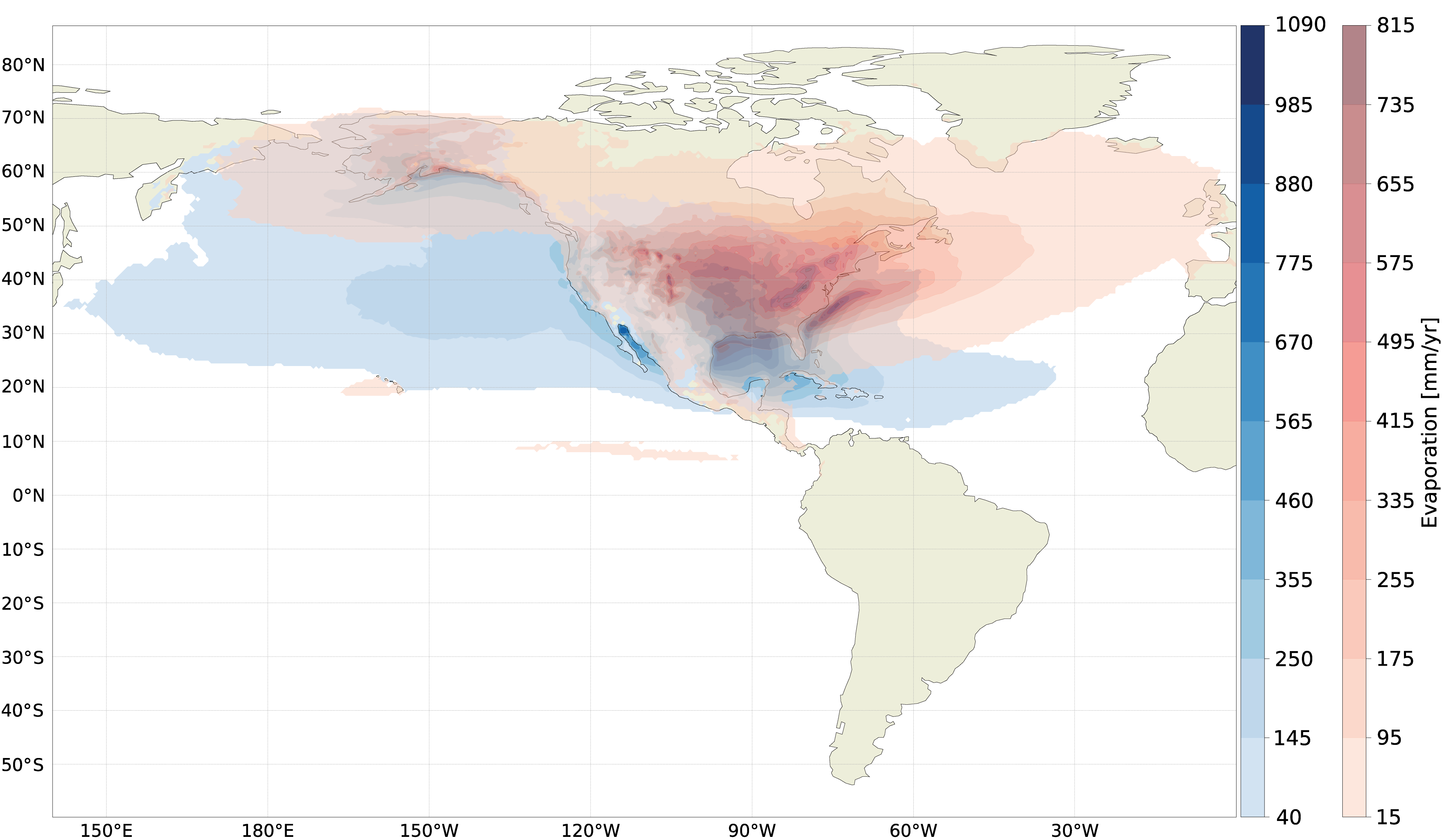
Figure 1 illustrates the extent of atmospheric moisture recycling in different regions. The blue sheds represent where most of the mean annual precipitation of the area shown evaporates from, while the red sheds indicate where most of the mean annual evaporation from the area precipitates again. Areas with internally recycled precipitable moisture appear purple, as these are areas where the red and blue sheds overlap. The time period of study is 2008–2017.
Humanity thus faces a three-headed global water crisis.
We are failing to meet human water demands while misusing and polluting water, causing harm to billions of people.
Global environmental change is causing rising frequency and severity of extreme episodes of too much or too little water, such as droughts, floods, storms and wildfires.
Human actions are now such a large force of change on Earth that the hydrological cycle itself is changing and interacting with climate and ecological change, which threatens the source of all freshwater—precipitation
We face a systemic crisis of water, which is both local and global. It puts at risk all of the Sustainable Development Goals (SDGs): from SDG 6, our ability to ensure universal access to clean water and sanitation; to food security and health; to enabling sustainable cities and communities; to ending poverty and inequalities; to enabling trade for sustainable growth; and to avoiding conflict within and between states. Vulnerable countries and communities—women and girls, farmers and small businesses, and young people who will be forced to migrate for work—will be impacted first and the most.
Learning from past failures
We must rethink how we approach the economics and governance of water to achieve a more sustainable, just and prosperous future for all.
We have failed in the past because our approaches to water have been:
- Too narrow—We have failed to recognise how neglecting to act on water will undermine not only universal access to safe water and sanitation but virtually all of the SDGs. We have also failed to take full advantage of the role and remit of government policy, limiting it to fixing market failures and filling the gaps of private sector activity. Our sectoral policies are further reinforcing a narrow response to the interconnected water crisis.
- Too local—We have sought to manage water locally, or through agreements and treaties on transboundary watercourses and lakes, without recognising how communities and countries are interconnected through the global water cycle, which include the atmospheric moisture flows that account for the larger portion of all precipitation globally. No country—even the largest—relies on its own territory as the source for more than half of its rainfall.
- Too short-sighted—We have dealt with growing demand for water by depleting the natural capital, including wetlands, which ensures a sustainable supply of water and the services it provides. The hidden cost of this depletion today, such as through excessive groundwater extraction, is the reduction in water’s ability to create future value, jobs and incomes. Even when governments identify long-term objectives, they often fall short in implementing effective policies to deliver on them.
- Too divided—We have failed in too many cities and countries to create durable partnerships between all stakeholders, designed and structured to deliver the public interest. In the area of water utilities, for example, both the public sector and private market operators have too often failed to deliver cost-effective, widely accessible and resilient services, thus worsening inequality. Meanwhile, we have allowed legacy water rights linked to property ownership to sustain inequalities. We have also failed to value local knowledge and diverse perspectives.
- Too incremental—Our business-as-usual approaches—too narrow, local, short-horizoned and divided—have been out of sync with a world of tipping points and potentially cataclysmic and irreversible change. Our efforts remain largely focused on blue water (streamflow and stored water) and rest on the assumption that supply shocks are within bounds of natural variability—hence the belief in extreme water events being, say, “once-in-a-1000 years” or “once-in-50 years”—and thus manageable through, for example, more irrigation and groundwater extraction. We have yet to build the deep uncertainty into decision-making that is now inherent in an Earth system that is crossing tipping points, with cascading effects from one ecosystem to the next, and irreversible regime shifts.
We must correct these failings, with more systems thinking and bolder collective actions. This requires working together, from local to global levels, to manage water in a more integrated, inclusive and effective way.
A new framework for the
economics of water
We have what it takes to put water onto a sustainable and equitable track. We have the scientific knowledge. We have most of the technologies. We have the policy knowhow and ability to learn from best practices and adapt and spread them widely. And we have the finance.
Our task is to organise these resources effectively—locally, regionally, nationally and globally—to restore balance in the global water cycle and create a safe and just water future that helps achieve all our SDGs.
To do so we must reframe our approach to water, recognising what the science tells us, and reshaping our economic and governance systems.
-
We must manage the global water cycle as a global common good
We must manage the global water cycle as a global common good, to be protected collectively and in the interests of all. We must recognise the interdependence of countries through the global water cycle: water is increasingly intertwined with climate change and the depletion of the planet’s natural capital; water is critical to food security as well as all the SDGs; and water cannot be put back on a sustainable trajectory without justice and equity in every corner of the globe.
We can protect the global water cycle if we take action collectively. We must embrace collective intelligence and a shared sense of purpose. And we must structure investments, institutions and partnerships to ensure outcomes that are both equitable and sustainable for all.
We must ensure that justice prevails when it comes to water. This means protecting the environment as well as all life in it and making sure that everyone—regardless of age, gender, culture or background—has access to water, and that we do not damage or diminish the ecosystems that will ensure future generations get the water they will need. Without institutional and policy reforms to address inequities, we will not get water back onto a sustainable trajectory.
-
We must adopt an outcomes-focused, mission-driven approach to achieve water equity and sustainability
We must embark on a mission-oriented approach to mobilise multiple stakeholders around specific water goals that offer the greatest public value, locally and globally.
- We must use this approach to develop multi-stakeholder partnerships among the public, private and civil society sectors, formal and informal, and to shape markets, direct investment, and design policy instruments and institutions in an outcomes-oriented way to deliver on these water goals.
- We must redefine how the public and private sectors interact, unlocking higher levels of investment, while ensuring that profits are reinvested in communities and infrastructure and services.
- We must cease underpricing water. Proper pricing and targeted support for the poor will enable water to be used more efficiently in every sector, more equitably in every population and more sustainably both locally and globally. We must reflect water’s non-economic value in decision-making to protect the broader ecosystem it preserves and on which it depends.
- We must correct the misallocation of water via property rights that create inequities between different groups—including Indigenous Peoples and local communities, as well as landowners and non-landowners—and which lead to fragmented water management and a failure to incentivise sustainable water use. We must address legacy issues such as land ownership lock-ins tied to water access and arrangements that grant corporations access to free water from natural sources. Allocation mechanisms should ensure that water is accessible by all, regardless of their property rights.
- We must tackle rent-seeking behaviour and regulatory capture, to prevent narrow interests from obstructing broader progress towards water sustainability. Such practices have hindered important reforms, including measures to curb over-extraction of water in agriculture.
- We must use this approach to spur the collective actions needed globally: by aligning policies including disseminating major water innovations and supporting bottom-up experimentation, and mobilising finance internationally to support investments in low- and middle-income countries.
- Underpinning all our efforts, we must reshape multilateral governance of water, which is currently fragmented and not up to the challenge.
Scaling up investments in water through new public–private partnership models
The water sector has been plagued with failures in both public sector and private sector run systems.
- Globally, the water sector has been dominated by the public sector. However, public investment in water has been a low priority for many governments. Many have taken a short-term approach to water infrastructure and neglected asset health, unsurprisingly leading to high rates of service disruptions and leakage and to non-revenue water (NRW).
- In countries with private sector involvement—either through contracting or concessions (for fixed terms) or less commonly through outright privatisation—poorly designed contracts and regulatory failure are common. While private participation has in several instances led to improvements in delivery efficiency and standards, regulatory frameworks have often focused on immediate targets rather than investments in long-term resilience, including the renewal of ageing infrastructure.
We must allow for a range of economic models, from full public sector ownership to various forms of public–private partnerships. However, to invest at scale and spur innovation in the water sector, the public sector needs to proactively take a systems approach and shape solutions with the private sector in a symbiotic way, co-investing in technology, skills and infrastructure.
We have to correct for the chronic underinvestment in water worldwide, including in most high-income countries where the water infrastructure is ageing and increasingly dysfunctional, and in low- and middle-income countries where it remains inadequate and holds back inclusive development.
Investments in water must be multiplied by a factor of three, by most estimates, to ensure universal access to safely managed water and sanitation and enable its more sustainable use in major sectors. These investments, in both green and grey infrastructure, will be significantly offset by the economic value they generate.
But the structure of finance is as important as its quantity. Patient, mission-oriented financing can direct public and private funds towards key water-related objectives, nationally and globally. Deployed strategically, such financing can spur innovation and generate wider socio-economic benefits while tackling pressing water challenges. Critically, regulatory frameworks must provide the right incentives for both operational efficiencies and investment in long-term system resilience. They must seek to avoid rent-seeking or value-extractive behaviour by private investors and create long-term value for the public.
There is substantial scope for the participation of both public and private investors in appropriate segments of the value chain of the water sector.
- At one end are activities that are effectively natural monopolies, such as the provision of main pipelines, due to their high capital requirements and sunk cost and long payback periods. Public authorities typically undertake these activities.
- A large part of the water value chain comprises activities that yield revenue streams that can deliver adequate returns to private investors while serving the public good. These include treatment and recycling plants.
- Across the value chain, we need investments in frontier technologies that can improve both efficiency and equity in water systems. These include advances in material science that enable membranes to filter industrial wastewater with extremely high efficiency, enabling its reuse for a wide range of purposes, and remote-sensing tools to detect and anticipate water variability, such as that adopted by Digital Earth Africa. While some of these already attract private sector investments, they will often need public–private co-investments or other forms of risk mitigation by governments or philanthropies.
We need to take lessons internationally, both from the poor examples of public–private partnerships in the past and the ones that have worked well in achieving good outcomes including reductions in water losses (NRW), long-term network resilience, and equitable and affordable access. Experience suggests a few key elements for success in the water distribution sector, which is where most private sector participation has been:
- Acceptance at the outset that long-term investment is necessary and a focus on outcome-based performance measures.
- Balanced incentives and risk-sharing so that investors see a route to appropriate economic returns while customers are protected from possible monopolistic pricing. Conditionalities, for example, are an effective policy tool to help steer public and private investment towards activities that maximise public benefits.
- Competent and independent regulators operating in the public’s best interest and sheltered from short-term political pressures.
- Regular tariff adjustments to reflect costs and enable timely maintenance and reinvestment.
- Adequate competition, to enable the regulator to drive performance through comparative assessment of regulated entities.
We must cease underpricing water
Our economic systems by and large fail to account for the value of water. This leads to the excessive and unsustainable use of finite freshwater resources and a corresponding lack of access for the poor and vulnerable in many places. We must systematically incorporate the values of water into decision-making, so it can be used far more efficiently in every sector, more equitably in every population and more sustainably, both locally and globally.
Consistent with the 2022 Global Biodiversity Framework, we must move forward in accounting for the multiple benefits of freshwater, which is a core element of the Earth’s natural resources. Water must be made visible on public and private balance sheets through natural resource accounting.
We have to fix today’s widespread underpricing of water if we are to tackle the growing crisis of the environment. Pricing encourages more efficient water use, generates revenues and enables water systems to be invested in, extended across an entire population, maintained and renewed. It also supports the use of water-saving innovations, which are essential to managing demand while supporting economic development and growth.
However, we need to accompany proper water pricing with appropriately targeted subsidies or transfers to ensure that it benefits poor and vulnerable communities. In fact, today’s implicit subsidies in many countries, reflecting free or underpriced water, are perverse as they typically benefit the better-off and largest commercial players the most. There are, on the other hand, examples of countries and local authorities that have adopted pricing and subsidy strategies aimed at both more efficient and equitable use of water—from Cambodia to Singapore to Burkina Faso. These models can be adapted to the different circumstances that countries face.
Mobilising international finance for low- and middle-income countries
There is no solution to the water crisis and to restoring balance in the global water cycle as a global common good that will not require greater international financial support for low- and middle-income countries.
Estimates suggest that around USD 200–400 billion per year of additional investments in low- and middle-income countries will be needed just to achieve universal access to clean drinking water, sanitation and hygiene by 2030. However, we also need larger investments in more efficient and sustainable use of water in all sectors, from agriculture to manufacturing, to secure the global water cycle. We must support adaptation to cope with the weather extremities that we will have to live with for years to come.
To achieve this additional financing, we must mobilise every stream of finance—from the national and international public sectors to private sector investors, to banks and institutional investors, and to philanthropies. The overall strategy must be to use the complementary strengths of these different sources to drive down the cost of capital and scale up finance for low- and middle-income countries.
There are three major approaches to unlocking resources and channelling them towards this purpose:
- reducing and re-directing inefficient subsidies;
- strengthening disclosure of water footprints; and
- establishing “Just Water Partnerships” to support investments in low- and middle-income countries
We must phase out and re-channel some USD 700 billion of subsidies
We need a strong equity and sustainability lens on all subsidies, with the aim of reducing those that are regressive and encourage environmentally unsound practices and using the freed-up resources to incentivise more efficient and inclusive use of water.
- Water and sanitation subsidies alone amount to approximately USD 300 billion annually in the developing world. As we highlighted earlier, such subsidies typically favour the well-off and corporations more than the poor.
- Agriculture subsidies globally amount to approximately USD 500 billion annually of which more than USD 400 billion have been assessed to be price-distorting. Much of this can be redirected to encourage environmentally friendly practices, such as the reduction of excessive groundwater extraction and water-intensive irrigation methods, and the incentivisation of technologies like direct-seeded rice and new crops that consume less water.
- Non-revenue water also costs billions globally. Eliminating these leaks can generate significant public sector savings.
Strengthening disclosure of water footprints
Transparency is key in channelling resources, both credit and investments, towards activities that enhance rather than degrade the water ecosystem. As in green and transition finance at large, we must build on current initiatives to develop water accounts, high-integrity data on water footprints and frameworks for disclosure of risks and impacts of water insecurity on economic activities.
Governments should work towards adopting mandatory water disclosure requirements that are consistent and aligned with international best practices, including Target 15 of the new Global Biodiversity Framework. We must at the same time generate momentum through high-impact, voluntary actions by coalitions involving the private sector and civil society organisations such as CDP.
A critical priority must be to strengthen capacities to collect water-related data and use it to track progress and adapt actions to achieve the required ambitions in SDG 6 and beyond. We must also develop open public and private water data systems to create a more transparent assessment of water risks and benefits.
- There is currently a proliferation of data networks operated by their owners for specific uses and at different spatial and temporal scales. Most are location specific and do not take into account water risk or reporting in the full value chain, let alone provide an assessment informed by the materiality of water to a given part of the value chain. For example, water is typically intensively used in the raw materials portion of the value chain, which is rarely reported on or evaluated.
- Overcoming today’s fragmentation by setting standards and ensuring consistency in data quality, access, methodology and availability across different organisations and jurisdictions is key. New technologies, such as low-cost satellite monitoring of key water parameters, can help improve water data collection and analysis.
To date, water data and indicators have been used by some international financial institutions to structure financial instruments such as water bonds, sustainability-linked bonds and, most recently, water footprint loans. However, a more robust water data and disclosure system, both at country and global levels, would support substantially higher financing flows from both public and private sources into the sector.
We must establish Just Water Partnerships
We must establish Just Water Partnerships (JWPs) to enable investments in water resilience and sustainability in low- and middle-income countries, in ways that contribute to both national development goals and the global common good.
The multilateral development banks, regional development banks and development finance institutions must work in close concert with national governments, city and local authorities and public development banks to support investments on their own balance sheets as well as to catalyse greater private finance. The economic returns on these investments will vastly exceed their costs. Such collaboration should also support multi-stakeholder partnerships among public and private sectors, and civil society.
JWPs should involve several essential dimensions:
- Moving from a project-based to a country platform approach for water, similar to that being adopted in the Just Energy Transition Partnerships launched at COP26. Countries must take ownership of their JWPs and work with development banks and other stakeholders to shape policies, engage in capacity-building programmes to drive large-scale systemic change and mobilise investment.
- Strengthening the enabling environment for investments via a robust set of regulations and institutional arrangements, and by preparing a pipeline of well-prepared and bankable projects. This could involve structuring and pooling together projects to attract investors who might otherwise shun small projects. For instance, the Kenyan Pooled Water Fund (KPWF) bundles water projects into a single investment opportunity. By serving as an intermediary between the projects and funding sources, KPWF helps attract investment and diversify risk for investors, leading to greater infrastructure funding.
- Reducing and sharing investment risks to reduce the cost of capital and catalyse greater private finance. This can be achieved through co-investments, first loss guarantees, hedging against currency risks and political risk insurance. It will also require blended finance instruments that have concessional elements particularly for lower-income countries. Risks can also be diversified by aggregating projects and creating new water asset classes that can attract institutional investors.
We must move ahead on high potential opportunities
The current decade provides a critical window for actions to avoid a growing calamity. We must avoid being daunted by the complexity of the challenge—in particular, the “wicked” interaction of water and climate—and deferring action until we have comprehensive or near perfect solutions. We cannot let the perfect be the enemy of what is urgent and necessary.
We must move ahead to seize the high potential opportunities for which the methods already exist, and where we can move the needle significantly in restoring global water sustainability and delivering tangible benefits to citizens everywhere, particularly the most vulnerable. Our task is to develop capacities for effective implementation in each case, drive down the costs of technologies by adopting them at scale and mobilise the finance needed especially for low- and middle-income countries.
First, we must invest urgently in freshwater storage systems, which have been depleted to the point of being greatly inadequate even in meeting today’s needs. Groundwater reserves are in critical danger in several regions in the Global South as well as in Europe, underscoring the urgent need to protect natural storage systems.
- We must fulfil our commitment at the Convention on Biological Diversity COP15 to protect 30% of terrestrial, inland waters and coastal and marine areas by 2030 (30-by-30). These natural systems account for the vast bulk of today’s water storage globally. The wetlands, in particular, play an important role in regulating water flows and naturally filtering water, while also reducing the costs needed to avoid droughts, floods and downstream water treatment.
- We must make greater use of technologies to monitor groundwater and help stabilise aquifers. We must also invest in better maintenance of ageing built storage facilities and in expanding infrastructure in the developing world.
- Critically, however, we must move from an inefficient, fragmented approach, and an institutional bias towards large built infrastructure in many countries, to recognising that all storage—natural or built, big or decentralised, underground or on the surface—must be managed as interdependent parts of a larger water cycle.
Second, we must reduce massive inefficiencies in water distribution and the leakages that constitute NRW. Some 40% of piped water in cities is wasted due to leakage caused by ageing water pipelines. Prioritising sustained maintenance and use of existing technologies such as PVC pipes (which are less leak-prone compared to cast iron) and leak-detection and advanced metering tools, can significantly lower water leakage.
Third, we must vastly increase water recycling and develop the urban circular water economy. Today’s largely untreated industrial and urban wastewater results in immense pollution, with high economic and social costs. Industrial water accounts for about 20% of today’s global water withdrawals but only 20% is currently treated and much less is recycled. The payback period for water recycling is relatively short. Beverage companies can see a return on investment within about seven months. PVC plants see a return within five years. Wastewater from industry and data centres can be used for district heating or treated and recycled to yield not only water but also energy, fertiliser and organic inputs.
Fourth, we must incentivise and scale up smart irrigation solutions and farming of less water-intensive crops. Today, agriculture uses 80% of the world’s consumed water. There is scope for much greater use of micro irrigation and smart agriculture, which is a win-win for both ordinary farmers and the environment. These methods will typically have to be accompanied by transparent measurement and explicit caps on water use, and by redirecting today’s subsidies away from more water-intensive crops, so as to ensure that more water-efficient irrigation does not merely lead to greater water consumption as a whole.
Fifth, we must increase water recycling in the mining sector and reduce the water footprint of manufacturing. For example, lithium, which is widely used in batteries for electric vehicles and energy storage systems, requires a significant amount of water. We must implement water-efficient processes such as closed-loop systems, which capture and recycle the water used in the production process. There are also emerging innovative methods such as direct lithium extraction, which can extract lithium from brine sources without the need for excessive amounts of water.
We must reshape multilateral governance of water
We must embark on a fundamental reassessment and dialogue about how we can reshape multilateral governance of water, recognising the urgency of achieving universal access to safe water and sanitation, improving how efficiently water is used in every sector and keeping the world within safe planetary boundaries.
Today’s global governance architecture for water is not fit for purpose. It is fragmented, siloed and underinvested in. These realities result in inconsistent and duplicated efforts to address shared water crises. While water has received some attention in various legal instruments, policies and implementation plans, it has to be brought to the forefront of conversations around food security, climate change, biodiversity and pollution, and placed at the centre of the solutions.
We should envision and work towards the right institutional framework, governance designs, coordinating mechanisms and normative instruments that will take care of the global water cycle as a global common good so as to foster prosperity, equity and justice for all.
To improve existing global mechanisms, we can take several steps:
- evaluate and identify gaps and inconsistencies in existing water-related global instruments and normative frameworks;
- strengthen existing mechanisms, such as UN-Water and the Ramsar Convention on Wetlands, to enable better coordination and delivery across stakeholders and produce more coherent and outcomes-oriented agendas across various UN agencies and programmes;
- provide for better-quality, higher frequency data via early warning and monitoring systems, which can help us track progress, identify priorities and adapt our decisions on a proper base of evidence;
- appoint and resource a UN Water Envoy who could lead and coordinate these multilateral efforts in the short term; and
- strengthen partnerships between the United Nations and the World Bank, IMF and other multilateral financial institutions, to ensure alignment of programmes and to expand access to resources for water-related action, particularly for low- and middle-income countries and vulnerable groups and communities, across relevant SDGs.
We must begin a dialogue process necessary towards the establishment of longer-term structural governance alternatives to address the local to global water crisis head-on. These could include the possibility of a new Water Convention or Global Water Pact, which would be designed to promote greater collaboration and cooperation across nations and stakeholders. The alternatives may also involve the creation of a high-level scientific panel and open knowledge platform on water as an advisory mechanism to facilitate a new Water Convention that builds on the IPCC and IPBES experience.
We must recognise the role that trade can play to promote more sustainable and efficient use of water. Today, one in five calories consumed is traded. Trade policy can be a powerful tool for enabling water-scarce countries to shift towards producing less water-intensive crops. To achieve this, we must identify and monitor the hidden cost of water in international trade—the virtual water embedded in the trade of goods that is estimated at about 300 km3 per year. By adapting current international trade arrangements, we can promote sustainable water use, for example, by highlighting efficient and wasteful water subsidies, incorporating water conservation standards in trade agreements and ensuring that trade policies do not worsen water scarcity in water-stressed regions.
We must join hands to develop skills and capacity globally and gain the full value of collective intelligence. We must develop and share policy-implementation capabilities to address the universal challenge of too little, too much and too dirty water. In particular, it is imperative that we prioritise gender equality in water decision-making. We must also empower farmers, women, youth, workers, Indigenous Peoples and local communities, and consumers who are at the frontlines of water conservation.
We must establish mechanisms to strengthen development, innovation and transfer of sustainable water use related technologies especially with low- and middle-income countries.
Turning the water crisis to advantage
We must gain inspiration from the wisdom of Indigenous Peoples and traditional communities who understand and treasure water as a shared resource, to be passed down from generation to generation.
We can convert the water crisis to an immense global opportunity, for economy-wide innovation and a new social contract between all actors—with justice and equity at the centre of our efforts. Only in this way can we deliver on the human right to safe water and keep our Earth System safe for humanity.

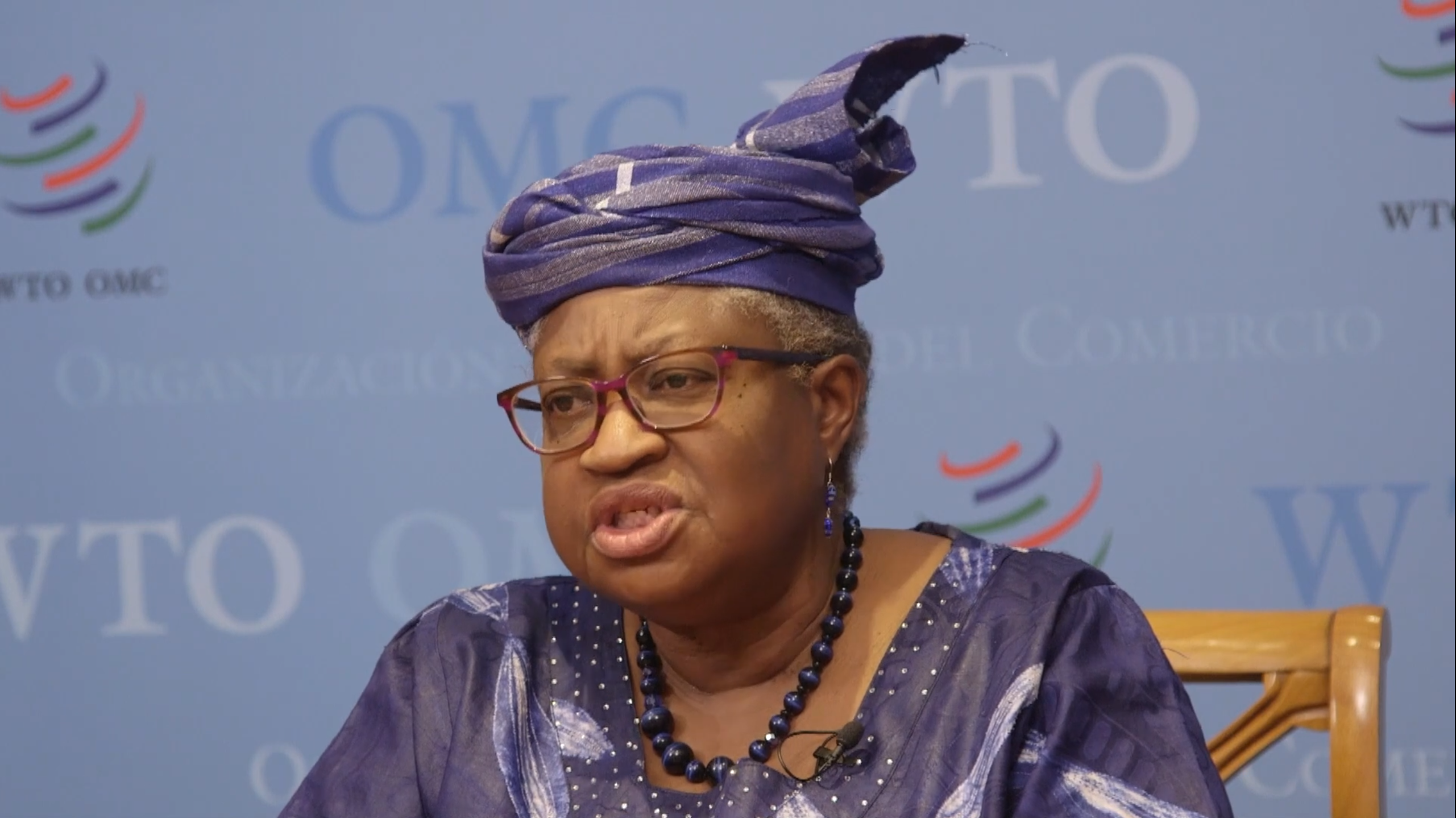
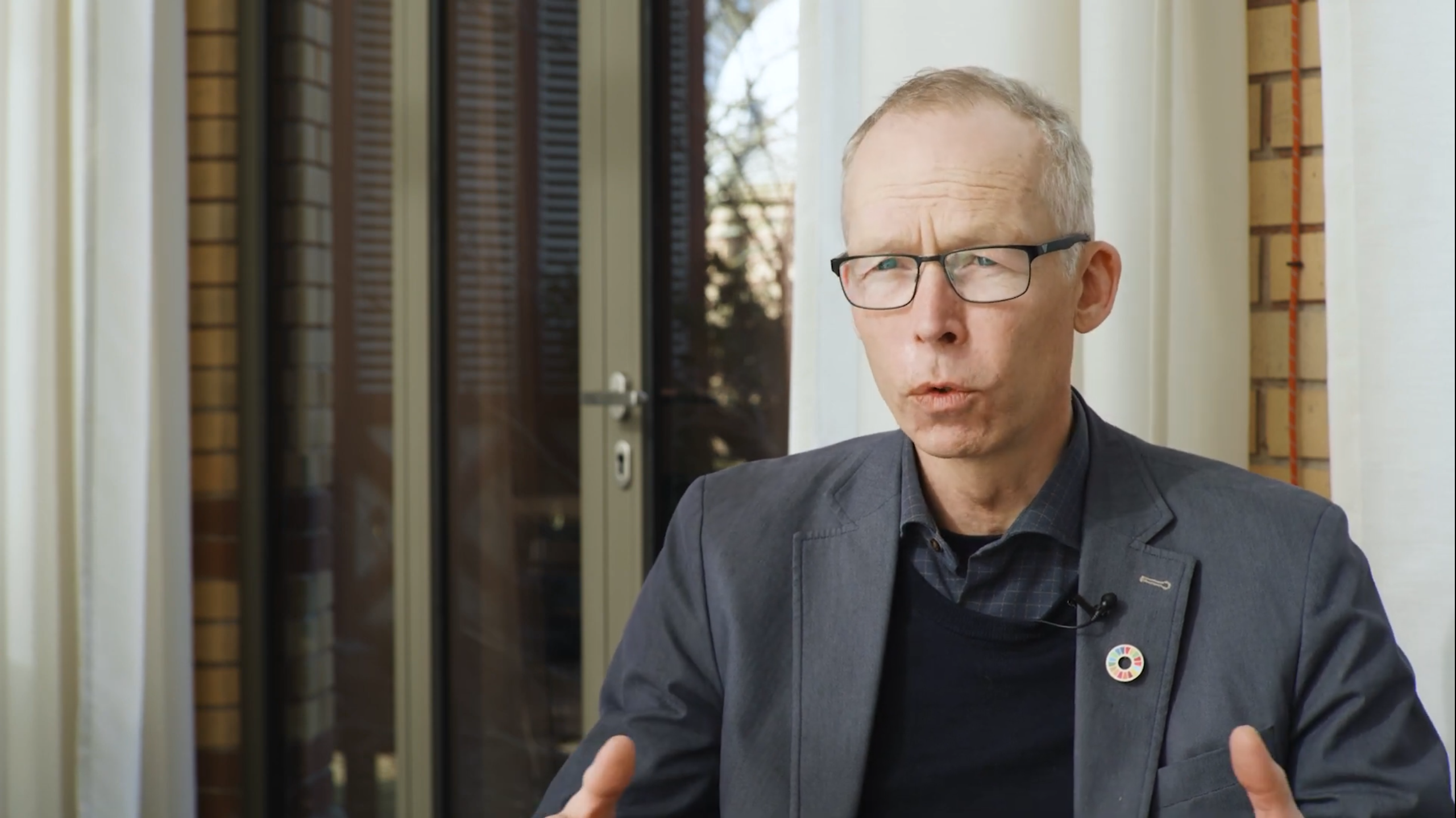
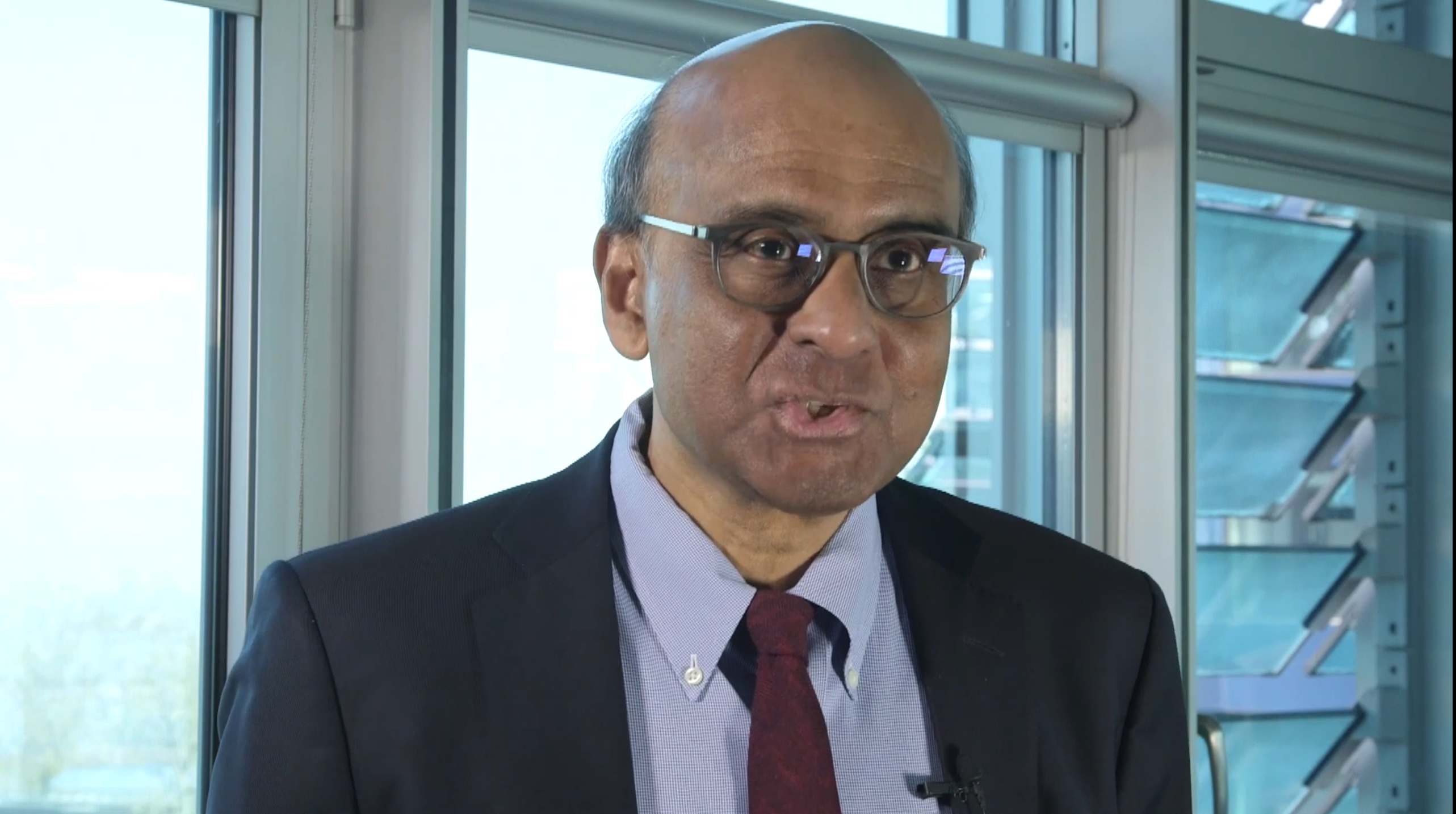

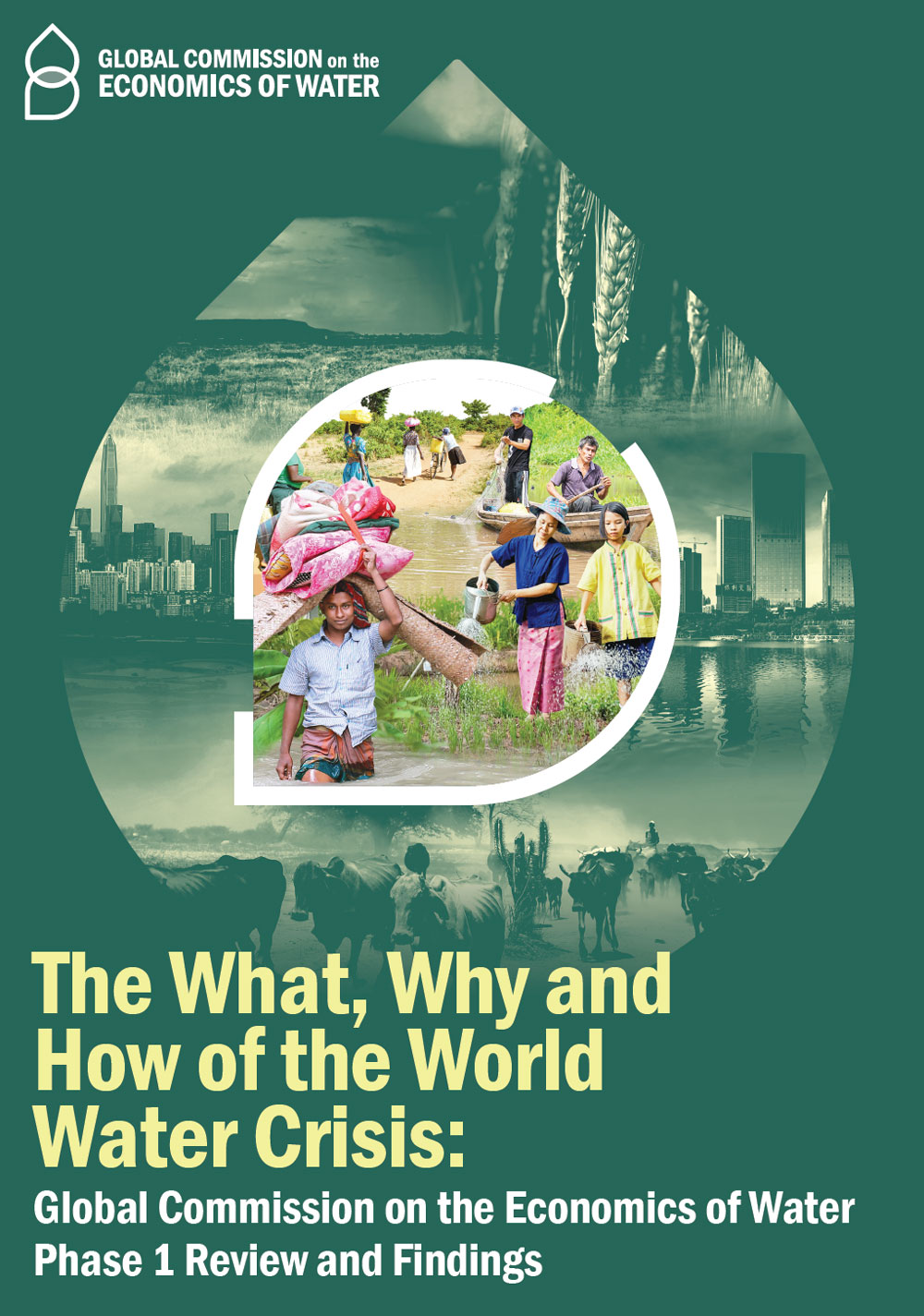

the Tide
By the Global Commission on the Economics of Water
We will fail on climate change if we do not solve water. We will also fail on all the Sustainable Development Goals (SDGs).
No person, place, economy or ecosystem will be spared.
We are seeing the consequences not of freak events, nor of population growth and economic development, but of having mismanaged water globally for decades. As the science and evidence show, we now face a systemic crisis that is both local and global.
Our collective actions have pushed the global water cycle out of balance for the first time in human history, wreaking increasing damage on communities everywhere. Further, countries are interconnected not only through transboundary rivers or streams of groundwater, but also through atmospheric flows of water vapour. And dangerously, we face water’s deepening connection with climate change and the loss of biodiversity, with each reinforcing the other.
We can only fix this collectively. And if we move with urgency.
A sustainable and just water future can be achieved. It requires transforming the economics and restructuring the governance of water. We must take actions that are bolder, more integrated, across sectors and more networked at national, regional and global levels.
First, we must manage the global water cycle as a global common good, to be protected collectively and in the interests of all.
It means recognising that communities and nations are connected regionally and globally; that water is increasingly intertwined with climate change and the depletion of the planet’s natural capital; that water is critical to food security as well as all the SDGs; and that water cannot be put back on a sustainable trajectory without justice and equity in every corner of the globe.
Second, we must adopt an outcomes-focused, mission-driven approach to water encompassing all the key roles it plays in human well-being.
We must deliver on the human right to safe water. We must act collectively to stabilise the global water cycle. It means mobilising multiple stakeholders, public, private, civil society and local community; utilising innovation policy to catalyse solutions to concrete problems; and scaling up investments in water through new modalities of public-private partnerships. And we must ensure that the value that is created collectively gets shared widely.
Third, we must cease underpricing water.
Proper pricing along with targeted support for the poor will enable water to be used more efficiently in every sector, more equitably in every population and more sustainably both locally and globally. We must also account for water’s non-economic value in decision-making to ensure we protect nature, on which the planet and all life depend.
Fourth, we must phase out some USD 700 billion of subsidies in agriculture and water each year, which tend to generate excessive water consumption and other environmentally damaging practices.
We must drastically reduce leakages in water systems (“non-revenue water”) that cost billions annually, by prioritising sustained maintenance efforts. We must accelerate efforts to require disclosure of water footprints, which are key to steering capital and consumer preferences in favour of sustainable practices. Each of these steps will allow us to re-direct resources towards incentivising water conservation and universal access.
Fifth, we should establish Just Water Partnerships (JWPs) to enable investments in water access, resilience and sustainability in low- and middle-income countries, using approaches that contribute to both national development goals and the global common good.
JWPs should drive down the cost of capital by using the complementary strengths of every stream of finance—rechannelling today’s inefficient domestic subsidies, leveraging on the multilateral development banks and development finance institutions, and crowding in private companies, banks and institutional investors, and philanthropic money. The economic returns on these investments will vastly exceed their costs. The JWPs should also maximise synergies with climate change strategies and national programs to achieve inclusive growth.
Sixth, we must move ahead on the opportunities that can move the needle significantly in the current decade.
Fortifying freshwater storage systems, especially the natural assets such as wetlands and groundwater, which have been dangerously depleted. Developing the urban circular water economy especially by recycling industrial and urban wastewater, which remains largely untreated. Reducing water footprints in manufacturing, including the reuse of water in producing critical materials such as the lithium we need for electrification. Shifting agriculture to precision irrigation, less water-intensive crops and drought-resilient farming that can also raise incomes. We must drive down the costs of technologies in each case by adopting them at scale.
Seventh, underpinning all our efforts, we must reshape multilateral governance of water, which is currently fragmented and not fit for purpose.
Trade policy must be used as a tool for more sustainable use of water, by incorporating water conservation standards in trade agreements, highlighting wasteful water subsidies and ensuring that trade policies do not exacerbate water scarcity in water-stressed regions. Multilateralism should also support capacity building for all, prioritise gender equality in water decision-making, and empower farmers, women, youth, Indigenous Peoples and local communities, and consumers who are at the frontlines of water conservation.
The world is headed for a massive water disaster
The disasters of 2022 are a warning of things to come. The unprecedented floods and droughts, cyclonic storms and heat waves, in one region today and another tomorrow. The devastating toll in human suffering, and in some cases, decades of human development wiped out in weeks.
But it is not just these extreme events that tell us we have a crisis on our hands. There is a long-standing tragedy that does not make the headlines. More than two billion people still lack access to safely managed water. One child under five dies every 80 seconds from diseases caused by polluted water. Hundreds of millions of children grow up stunted, their potential in life sharply diminished.
The crisis has already pushed whole communities and regions in the Global South into severe food insecurity. The water-energy-food nexus, made worse by food export restrictions, has also contributed to major food price spikes in the last 15 years, exacerbating their suffering.
Without urgent action, the damage will accelerate and grow more severe in all these critical dimensions.
We are seeing the consequences not of freak events, nor of population growth and economic development, but of our mismanagement of water globally for decades. We have changed rainfall patterns and failed to preserve freshwater ecosystems, to manage demand to avoid overuse, to prevent contamination, to foster recycling and to develop and share water-saving technologies. We now face the prospect of a 40% shortfall in freshwater supply by 2030, with severe shortages in water-constrained regions.
And fundamentally, as the science and evidence show, this mismanagement of water has pushed the global water cycle out of balance for the first time in human history. We have breached the planetary boundaries for water that keep the Earth’s system safe for humanity and all life.
Dangerously, the water crisis is increasingly intertwined with global warming and the loss of biodiversity, with each reinforcing the other. The cumulative impacts on the climate and biosphere are changing the source of all freshwater—precipitation—and that is resulting in a shift in the supply of water across the entire world. A key driver is global warming—a global energy imbalance that intensifies the water cycle, adding about 7% of moisture for each 1°C of global mean temperature rise. In addition, land use change (predominantly deforestation, wetland depletion, land degradation and infrastructure development) is now impacting precipitation patterns, and how rain is partitioned between green (soil moisture/vapour) and blue water (runoff/liquid) flows.
However, water is not just a casualty but also a driver of the climate crisis. Behind all carbon storage in nature, there is freshwater. Extreme water events cause an immediate loss of carbon uptake in nature. Droughts lead to fires and massive loss of biomass, carbon and biodiversity. The loss of wetlands is depleting the planet’s greatest carbon store, while the drop in soil moisture is reducing the terrestrial and forest ecosystem’s ability to sequester carbon. It risks turning these natural ecosystems into sources of greenhouse gas emissions in the years to come, with devastating consequences for the pace of global warming.
We will fail on climate change if we fail on water. Equally, we have to coordinate our strategies for the two to ensure that the transition to low emission energy sources reduces, rather than increases, pressure on scarce water resources. We should also recognise water’s critical role in climate mitigation and adaptation strategies, including the role of wetlands in providing resilience against floods and droughts. If we don’t plan this properly, there is real risk that we both exacerbate the water crisis and undermine efforts to halt and reduce the costs of climate change itself.
We must also recognise that communities and countries are interconnected through the global water cycle. They are not only interconnected by transboundary blue water flows but also through green water, i.e., atmospheric green water flows of water vapour, flows which expand extend far beyond traditional watershed boundaries.
- Precipitation—the source of all freshwater—is for each country in the world determined by a number of factors: domestic water use and governance, collective management of the climate system, as well as the state of neighbouring countries forests and other ecosystems as they generate green water flow, which turns into rainfall when moisture is recycled and travels downwind.
- Moisture recycling studies have shown that continental green water flow is important for many regions to sustain their precipitation. Globally, about 40 to 50% of terrestrial precipitation originates from vapour flow over land via green water moisture recycling. Countries are interconnected via atmospheric moisture pathways directing evaporation through the atmosphere to precipitation in downwind areas, creating so-called precipitation sheds (source areas) and evaporation sheds (sink areas) of rainfall. Figure 1 illustrates the extent and volumes of green water flows across the world including terrestrial moisture imports, exports and internal recycling across regions.





Figure 1 illustrates the extent of atmospheric moisture recycling in different regions. The blue sheds represent where most of the mean annual precipitation of the area shown evaporates from, while the red sheds indicate where most of the mean annual evaporation from the area precipitates again. Areas with internally recycled precipitable moisture appear purple, as these are areas where the red and blue sheds overlap. The time period of study is 2008–2017.
Humanity thus faces a three-headed global water crisis.
We are failing to meet human water demands while misusing and polluting water, causing harm to billions of people.
Global environmental change is causing rising frequency and severity of extreme episodes of too much or too little water, such as droughts, floods, storms and wildfires.
Human actions are now such a large force of change on Earth that the hydrological cycle itself is changing and interacting with climate and ecological change, which threatens the source of all freshwater—precipitation
We face a systemic crisis of water, which is both local and global. It puts at risk all of the Sustainable Development Goals (SDGs): from SDG 6, our ability to ensure universal access to clean water and sanitation; to food security and health; to enabling sustainable cities and communities; to ending poverty and inequalities; to enabling trade for sustainable growth; and to avoiding conflict within and between states. Vulnerable countries and communities—women and girls, farmers and small businesses, and young people who will be forced to migrate for work—will be impacted first and the most.
Learning from past failures
We must rethink how we approach the economics and governance of water to achieve a more sustainable, just and prosperous future for all.
We have failed in the past because our approaches to water have been:
- Too narrow—We have failed to recognise how neglecting to act on water will undermine not only universal access to safe water and sanitation but virtually all of the SDGs. We have also failed to take full advantage of the role and remit of government policy, limiting it to fixing market failures and filling the gaps of private sector activity. Our sectoral policies are further reinforcing a narrow response to the interconnected water crisis.
- Too local—We have sought to manage water locally, or through agreements and treaties on transboundary watercourses and lakes, without recognising how communities and countries are interconnected through the global water cycle, which include the atmospheric moisture flows that account for the larger portion of all precipitation globally. No country—even the largest—relies on its own territory as the source for more than half of its rainfall.
- Too short-sighted—We have dealt with growing demand for water by depleting the natural capital, including wetlands, which ensures a sustainable supply of water and the services it provides. The hidden cost of this depletion today, such as through excessive groundwater extraction, is the reduction in water’s ability to create future value, jobs and incomes. Even when governments identify long-term objectives, they often fall short in implementing effective policies to deliver on them.
- Too divided—We have failed in too many cities and countries to create durable partnerships between all stakeholders, designed and structured to deliver the public interest. In the area of water utilities, for example, both the public sector and private market operators have too often failed to deliver cost-effective, widely accessible and resilient services, thus worsening inequality. Meanwhile, we have allowed legacy water rights linked to property ownership to sustain inequalities. We have also failed to value local knowledge and diverse perspectives.
- Too incremental—Our business-as-usual approaches—too narrow, local, short-horizoned and divided—have been out of sync with a world of tipping points and potentially cataclysmic and irreversible change. Our efforts remain largely focused on blue water (streamflow and stored water) and rest on the assumption that supply shocks are within bounds of natural variability—hence the belief in extreme water events being, say, “once-in-a-1000 years” or “once-in-50 years”—and thus manageable through, for example, more irrigation and groundwater extraction. We have yet to build the deep uncertainty into decision-making that is now inherent in an Earth system that is crossing tipping points, with cascading effects from one ecosystem to the next, and irreversible regime shifts.
We must correct these failings, with more systems thinking and bolder collective actions. This requires working together, from local to global levels, to manage water in a more integrated, inclusive and effective way.
A new framework for the
economics of water
We have what it takes to put water onto a sustainable and equitable track. We have the scientific knowledge. We have most of the technologies. We have the policy knowhow and ability to learn from best practices and adapt and spread them widely. And we have the finance.
Our task is to organise these resources effectively—locally, regionally, nationally and globally—to restore balance in the global water cycle and create a safe and just water future that helps achieve all our SDGs.
To do so we must reframe our approach to water, recognising what the science tells us, and reshaping our economic and governance systems.
-
We must manage the global water cycle as a global common good
We must manage the global water cycle as a global common good, to be protected collectively and in the interests of all. We must recognise the interdependence of countries through the global water cycle: water is increasingly intertwined with climate change and the depletion of the planet’s natural capital; water is critical to food security as well as all the SDGs; and water cannot be put back on a sustainable trajectory without justice and equity in every corner of the globe.
We can protect the global water cycle if we take action collectively. We must embrace collective intelligence and a shared sense of purpose. And we must structure investments, institutions and partnerships to ensure outcomes that are both equitable and sustainable for all.
We must ensure that justice prevails when it comes to water. This means protecting the environment as well as all life in it and making sure that everyone—regardless of age, gender, culture or background—has access to water, and that we do not damage or diminish the ecosystems that will ensure future generations get the water they will need. Without institutional and policy reforms to address inequities, we will not get water back onto a sustainable trajectory.
-
We must adopt an outcomes-focused, mission-driven approach to achieve water equity and sustainability
We must embark on a mission-oriented approach to mobilise multiple stakeholders around specific water goals that offer the greatest public value, locally and globally..
- We must use this approach to develop multi-stakeholder partnerships among the public, private and civil society sectors, formal and informal, and to shape markets, direct investment, and design policy instruments and institutions in an outcomes-oriented way to deliver on these water goals.
- We must redefine how the public and private sectors interact, unlocking higher levels of investment, while ensuring that profits are reinvested in communities and infrastructure and services.
- We must cease underpricing water. Proper pricing and targeted support for the poor will enable water to be used more efficiently in every sector, more equitably in every population and more sustainably both locally and globally. We must reflect water’s non-economic value in decision-making to protect the broader ecosystem it preserves and on which it depends.
- We must correct the misallocation of water via property rights that create inequities between different groups—including Indigenous Peoples and local communities, as well as landowners and non-landowners—and which lead to fragmented water management and a failure to incentivise sustainable water use. We must address legacy issues such as land ownership lock-ins tied to water access and arrangements that grant corporations access to free water from natural sources. Allocation mechanisms should ensure that water is accessible by all, regardless of their property rights.
- We must tackle rent-seeking behaviour and regulatory capture, to prevent narrow interests from obstructing broader progress towards water sustainability. Such practices have hindered important reforms, including measures to curb over-extraction of water in agriculture.
- We must use this approach to spur the collective actions needed globally: by aligning policies including disseminating major water innovations and supporting bottom-up experimentation, and mobilising finance internationally to support investments in low- and middle-income countries.
- Underpinning all our efforts, we must reshape multilateral governance of water, which is currently fragmented and not up to the challenge.
Scaling up investments in water through new public–private partnership models
The water sector has been plagued with failures in both public sector and private sector run systems.
- Globally, the water sector has been dominated by the public sector. However, public investment in water has been a low priority for many governments. Many have taken a short-term approach to water infrastructure and neglected asset health, unsurprisingly leading to high rates of service disruptions and leakage and to non-revenue water (NRW).
- In countries with private sector involvement—either through contracting or concessions (for fixed terms) or less commonly through outright privatisation—poorly designed contracts and regulatory failure are common. While private participation has in several instances led to improvements in delivery efficiency and standards, regulatory frameworks have often focused on immediate targets rather than investments in long-term resilience, including the renewal of ageing infrastructure.
We must allow for a range of economic models, from full public sector ownership to various forms of public–private partnerships. However, to invest at scale and spur innovation in the water sector, the public sector needs to proactively take a systems approach and shape solutions with the private sector in a symbiotic way, co-investing in technology, skills and infrastructure.
We have to correct for the chronic underinvestment in water worldwide, including in most high-income countries where the water infrastructure is ageing and increasingly dysfunctional, and in low- and middle-income countries where it remains inadequate and holds back inclusive development.
Investments in water must be multiplied by a factor of three, by most estimates, to ensure universal access to safely managed water and sanitation and enable its more sustainable use in major sectors. These investments, in both green and grey infrastructure, will be significantly offset by the economic value they generate.
But the structure of finance is as important as its quantity. Patient, mission-oriented financing can direct public and private funds towards key water-related objectives, nationally and globally. Deployed strategically, such financing can spur innovation and generate wider socio-economic benefits while tackling pressing water challenges. Critically, regulatory frameworks must provide the right incentives for both operational efficiencies and investment in long-term system resilience. They must seek to avoid rent-seeking or value-extractive behaviour by private investors and create long-term value for the public.
There is substantial scope for the participation of both public and private investors in appropriate segments of the value chain of the water sector.
- At one end are activities that are effectively natural monopolies, such as the provision of main pipelines, due to their high capital requirements and sunk cost and long payback periods. Public authorities typically undertake these activities.
- A large part of the water value chain comprises activities that yield revenue streams that can deliver adequate returns to private investors while serving the public good. These include treatment and recycling plants.
- Across the value chain, we need investments in frontier technologies that can improve both efficiency and equity in water systems. These include advances in material science that enable membranes to filter industrial wastewater with extremely high efficiency, enabling its reuse for a wide range of purposes, and remote-sensing tools to detect and anticipate water variability, such as that adopted by Digital Earth Africa. While some of these already attract private sector investments, they will often need public–private co-investments or other forms of risk mitigation by governments or philanthropies.
We need to take lessons internationally, both from the poor examples of public–private partnerships in the past and the ones that have worked well in achieving good outcomes including reductions in water losses (NRW), long-term network resilience, and equitable and affordable access. Experience suggests a few key elements for success in the water distribution sector, which is where most private sector participation has been:
- Acceptance at the outset that long-term investment is necessary and a focus on outcome-based performance measures.
- Balanced incentives and risk-sharing so that investors see a route to appropriate economic returns while customers are protected from possible monopolistic pricing. Conditionalities, for example, are an effective policy tool to help steer public and private investment towards activities that maximise public benefits.
- Competent and independent regulators operating in the public’s best interest and sheltered from short-term political pressures.
- Regular tariff adjustments to reflect costs and enable timely maintenance and reinvestment.
- Adequate competition, to enable the regulator to drive performance through comparative assessment of regulated entities.
-
We must cease underpricing water
Our economic systems by and large fail to account for the value of water. This leads to the excessive and unsustainable use of finite freshwater resources and a corresponding lack of access for the poor and vulnerable in many places. We must systematically incorporate the values of water into decision-making, so it can be used far more efficiently in every sector, more equitably in every population and more sustainably, both locally and globally.
Consistent with the 2022 Global Biodiversity Framework, we must move forward in accounting for the multiple benefits of freshwater, which is a core element of the Earth’s natural resources. Water must be made visible on public and private balance sheets through natural resource accounting.
We have to fix today’s widespread underpricing of water if we are to tackle the growing crisis of the environment. Pricing encourages more efficient water use, generates revenues and enables water systems to be invested in, extended across an entire population, maintained and renewed. It also supports the use of water-saving innovations, which are essential to managing demand while supporting economic development and growth.
However, we need to accompany proper water pricing with appropriately targeted subsidies or transfers to ensure that it benefits poor and vulnerable communities. In fact, today’s implicit subsidies in many countries, reflecting free or underpriced water, are perverse as they typically benefit the better-off and largest commercial players the most. There are, on the other hand, examples of countries and local authorities that have adopted pricing and subsidy strategies aimed at both more efficient and equitable use of water—from Cambodia to Singapore to Burkina Faso. These models can be adapted to the different circumstances that countries face.
Mobilising international finance for low- and middle-income countries
There is no solution to the water crisis and to restoring balance in the global water cycle as a global common good that will not require greater international financial support for low- and middle-income countries.
Estimates suggest that around USD 200–400 billion per year of additional investments in low- and middle-income countries will be needed just to achieve universal access to clean drinking water, sanitation and hygiene by 2030. However, we also need larger investments in more efficient and sustainable use of water in all sectors, from agriculture to manufacturing, to secure the global water cycle. We must support adaptation to cope with the weather extremities that we will have to live with for years to come.
To achieve this additional financing, we must mobilise every stream of finance—from the national and international public sectors to private sector investors, to banks and institutional investors, and to philanthropies. The overall strategy must be to use the complementary strengths of these different sources to drive down the cost of capital and scale up finance for low- and middle-income countries.
There are three major approaches to unlocking resources and channelling them towards this purpose:
- reducing and re-directing inefficient subsidies;
- strengthening disclosure of water footprints; and
- establishing “Just Water Partnerships” to support investments in low- and middle-income countries.
-
We must phase out and re-channel some USD 700 billion of subsidies
We need a strong equity and sustainability lens on all subsidies, with the aim of reducing those that are regressive and encourage environmentally unsound practices and using the freed-up resources to incentivise more efficient and inclusive use of water.
- Water and sanitation subsidies alone amount to approximately USD 300 billion annually in the developing world. As we highlighted earlier, such subsidies typically favour the well-off and corporations more than the poor.
- Agriculture subsidies globally amount to approximately USD 500 billion annually of which more than USD 400 billion have been assessed to be price-distorting Much of this can be redirected to encourage environmentally friendly practices, such as the reduction of excessive groundwater extraction and water-intensive irrigation methods, and the incentivisation of technologies like direct-seeded rice and new crops that consume less water.
- Non-revenue water also costs billions globally. Eliminating these leaks can generate significant public sector savings.
Strengthening disclosure of water footprints
Transparency is key in channelling resources, both credit and investments, towards activities that enhance rather than degrade the water ecosystem. As in green and transition finance at large, we must build on current initiatives to develop water accounts, high-integrity data on water footprints and frameworks for disclosure of risks and impacts of water insecurity on economic activities.
Governments should work towards adopting mandatory water disclosure requirements that are consistent and aligned with international best practices, including Target 15 of the new Global Biodiversity Framework. We must at the same time generate momentum through high-impact, voluntary actions by coalitions involving the private sector and civil society organisations such as CDP.
A critical priority must be to strengthen capacities to collect water-related data and use it to track progress and adapt actions to achieve the required ambitions in SDG 6 and beyond. We must also develop open public and private water data systems to create a more transparent assessment of water risks and benefits.
- There is currently a proliferation of data networks operated by their owners for specific uses and at different spatial and temporal scales. Most are location specific and do not take into account water risk or reporting in the full value chain, let alone provide an assessment informed by the materiality of water to a given part of the value chain. For example, water is typically intensively used in the raw materials portion of the value chain, which is rarely reported on or evaluated.
- Overcoming today’s fragmentation by setting standards and ensuring consistency in data quality, access, methodology and availability across different organisations and jurisdictions is key. New technologies, such as low-cost satellite monitoring of key water parameters, can help improve water data collection and analysis.
To date, water data and indicators have been used by some international financial institutions to structure financial instruments such as water bonds, sustainability-linked bonds and, most recently, water footprint loans. However, a more robust water data and disclosure system, both at country and global levels, would support substantially higher financing flows from both public and private sources into the sector.
-
We must establish Just Water Partnerships
We must establish Just Water Partnerships (JWPs) to enable investments in water resilience and sustainability in low- and middle-income countries, in ways that contribute to both national development goals and the global common good.
The multilateral development banks, regional development banks and development finance institutions must work in close concert with national governments, city and local authorities and public development banks to support investments on their own balance sheets as well as to catalyse greater private finance. The economic returns on these investments will vastly exceed their costs. Such collaboration should also support multi-stakeholder partnerships among public and private sectors, and civil society.
JWPs should involve several essential dimensions:
- Moving from a project-based to a country platform approach for water, similar to that being adopted in the Just Energy Transition Partnerships launched at COP26. Countries must take ownership of their JWPs and work with development banks and other stakeholders to shape policies, engage in capacity-building programmes to drive large-scale systemic change and mobilise investment.
- Strengthening of the enabling environment for investments via a robust set of regulations and institutional arrangements, and by preparing apipeline of well-prepared and bankable projects. This could involve structuring and pooling together projects to attract investors who might otherwise shun small projects. For instance, the Kenyan Pooled Water Fund (KPWF) bundles water projects into a single investment opportunity. By serving as an intermediary between the projects and funding sources, KPWF helps attract investment and diversify risk for investors, leading to greater infrastructure funding.
- Reducing and sharing investment risks to reduce the cost of capital and catalyse greater private finance. This can be achieved through co-investments, first loss guarantees, hedging against currency risks and political risk insurance. It will also require blended finance instruments that have concessional elements particularly for lower-income countries. Risks can also be diversified by aggregating projects and creating new water asset classes that can attract institutional investors.
-
We must move ahead on high potential opportunities
The current decade provides a critical window for actions to avoid a growing calamity. We must avoid being daunted by the complexity of the challenge—in particular, the “wicked” interaction of water and climate—and deferring action until we have comprehensive or near perfect solutions. We cannot let the perfect be the enemy of what is urgent and necessary.
We must move ahead to seize the high potential opportunities for which the methods already exist, and where we can move the needle significantly in restoring global water sustainability and delivering tangible benefits to citizens everywhere, particularly the most vulnerable. Our task is to develop capacities for effective implementation in each case, drive down the costs of technologies by adopting them at scale and mobilise the finance needed especially for low- and middle-income countries.
First, we must invest urgently in freshwater storage systems, which have been depleted to the point of being greatly inadequate even in meeting today’s needs. Groundwater reserves are in critical danger in several regions in the Global South as well as in Europe, underscoring the urgent need to protect natural storage systems.
- We must fulfil our commitment at the Convention on Biological Diversity COP15 to protect 30% of terrestrial, inland waters and coastal and marine areas by 2030 (30-by-30). These natural systems account for the vast bulk of today’s water storage globally. The wetlands, in particular, play an important role in regulating water flows and naturally filtering water, while also reducing the costs needed to avoid droughts, floods and downstream water treatment.
- We must make greater use of technologies to monitor groundwater and help stabilise aquifers. We must also invest in better maintenance of ageing built storage facilities and in expanding infrastructure in the developing world.
- Critically, however, we must move from an inefficient, fragmented approach, and an institutional bias towards large built infrastructure in many countries, to recognising that all storage—natural or built, big or decentralised, underground or on the surface—must be managed as interdependent parts of a larger water cycle.
Second, we must reduce massive inefficiencies in water distribution and the leakages that constitute NRW. Some 40% of piped water in cities is wasted due to leakage caused by ageing water pipelines. Prioritising sustained maintenance and use of existing technologies such as PVC pipes (which are less leak-prone compared to cast iron) and leak-detection and advanced metering tools, can significantly lower water leakage.
Third, we must vastly increase water recycling and develop the urban circular water economy. Today’s largely untreated industrial and urban wastewater results in immense pollution, with high economic and social costs. Industrial water accounts for about 20% of today’s global water withdrawals but only 20% is currently treated and much less is recycled. The payback period for water recycling is relatively short. Beverage companies can see a return on investment within about seven months. PVC plants see a return within five years. Wastewater from industry and data centres can be used for district heating or treated and recycled to yield not only water but also energy, fertiliser and organic inputs.
Fourth, we must incentivise and scale up smart irrigation solutions and farming of less water-intensive crops. Today, agriculture uses 80% of the world’s consumed water. There is scope for much greater use of micro irrigation and smart agriculture, which is a win-win for both ordinary farmers and the environment. These methods will typically have to be accompanied by transparent measurement and explicit caps on water use, and by redirecting today’s subsidies away from more water-intensive crops, so as to ensure that more water-efficient irrigation does not merely lead to greater water consumption as a whole.
Fifth, we must increase water recycling in the mining sector and reduce the water footprint of manufacturing. For example, lithium, which is widely used in batteries for electric vehicles and energy storage systems, requires a significant amount of water. We must implement water-efficient processes such as closed-loop systems, which capture and recycle the water used in the production process. There are also emerging innovative methods such as direct lithium extraction, which can extract lithium from brine sources without the need for excessive amounts of water.
-
We must reshape multilateral governance of water
We must embark on a fundamental reassessment and dialogue about how we can reshape multilateral governance of water, recognising the urgency of achieving universal access to safe water and sanitation, improving how efficiently water is used in every sector and keeping the world within safe planetary boundaries.
Today’s global governance architecture for water is not fit for purpose. It is fragmented, siloed and underinvested in. These realities result in inconsistent and duplicated efforts to address shared water crises. While water has received some attention in various legal instruments, policies and implementation plans, it has to be brought to the forefront of conversations around food security, climate change, biodiversity and pollution, and placed at the centre of the solutions.
We should envision and work towards the right institutional framework, governance designs, coordinating mechanisms and normative instruments that will take care of the global water cycle as a global common good so as to foster prosperity, equity and justice for all.
To improve existing global mechanisms, we can take several steps:
- evaluate and identify gaps and inconsistencies in existing water-related global instruments and normative frameworks;
- strengthen existing mechanisms, such as UN-Water and the Ramsar Convention on Wetlands, to enable better coordination and delivery across stakeholders and produce more coherent and outcomes-oriented agendas across various UN agencies and programmes;
- provide for better-quality, higher frequency data via early warning and monitoring systems, which can help us track progress, identify priorities and adapt our decisions on a proper base of evidence;
- appoint and resource a UN Water Envoy who could lead and coordinate these multilateral efforts in the short term; and
- strengthen partnerships between the United Nations and the World Bank, IMF and other multilateral financial institutions, to ensure alignment of programmes and to expand access to resources for water-related action, particularly for low- and middle-income countries and vulnerable groups and communities, across relevant SDGs.
We must begin a dialogue process necessary towards the establishment of longer-term structural governance alternatives to address the local to global water crisis head-on. These could include the possibility of a new Water Convention or Global Water Pact, which would be designed to promote greater collaboration and cooperation across nations and stakeholders. The alternatives may also involve the creation of a high-level scientific panel and open knowledge platform on water as an advisory mechanism to facilitate a new Water Convention that builds on the IPCC and IPBES experience.
We must recognise the role that trade can play to promote more sustainable and efficient use of water. Today, one in five calories consumed is traded. Trade policy can be a powerful tool for enabling water-scarce countries to shift towards producing less water-intensive crops. To achieve this, we must identify and monitor the hidden cost of water in international trade—the virtual water embedded in the trade of goods that is estimated at about 300 km3 per year. By adapting current international trade arrangements, we can promote sustainable water use, for example, by highlighting efficient and wasteful water subsidies, incorporating water conservation standards in trade agreements and ensuring that trade policies do not worsen water scarcity in water-stressed regions.
We must join hands to develop skills and capacity globally and gain the full value of collective intelligence. We must develop and share policy-implementation capabilities to address the universal challenge of too little, too much and too dirty water. In particular, it is imperative that we prioritise gender equality in water decision-making. We must also empower farmers, women, youth, workers, Indigenous Peoples and local communities, and consumers who are at the frontlines of water conservation.
We must establish mechanisms to strengthen development, innovation and transfer of sustainable water use related technologies especially with low- and middle-income countries.
Turning the water crisis to advantage
We must gain inspiration from the wisdom of Indigenous Peoples and traditional communities who understand and treasure water as a shared resource, to be passed down from generation to generation.
We can convert the water crisis to an immense global opportunity, for economy-wide innovation and a new social contract between all actors—with justice and equity at the centre of our efforts. Only in this way can we deliver on the human right to safe water and keep our Earth System safe for humanity.















